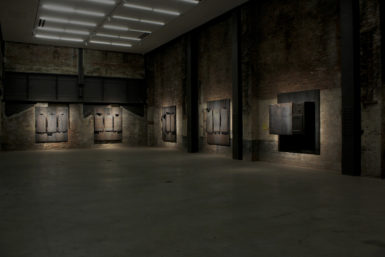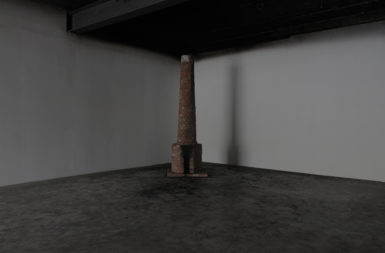[ad_1]

Installation view of Jannis Kounellis exhibition at Gavin Brown. Courtesy Gavin Brown.
Last Thursday, an art installer perched on a high ladder was applying small squares of gold leaf to a huge expanse of wall in the Harlem gallery Gavin Brown’s Enterprise, putting the finishing touches on a piece by the late artist Jannis Kounellis. The lighting for the artwork had not yet been finalized, and the brick walled room would have been dim if it weren’t for the gold, which seemed to provide its own light source, glowing transcendently from within.

Installation view of Jannis Kounellis exhibition at Gavin Brown. Courtesy Gavin Brown.
The Kounellis exhibition, which opens tomorrow, is the first substantial exhibition of his work since the Greek-born, Italian artist died last year of heart failure at age 80. Shortly before his death, Kounellis, who is known for his work with humble materials like burlap and lead, accompanied Brown to the Harlem space, which stretches over three floors of a former brewery on 127th Street. Brown has kept many of its huge rooms raw.
“It’s not a survey,” Brown said of the exhibition, which has taken three months to pull together in collaboration with Kounellis’s son and longtime partner Michelle Coudray. “It’s a call to arms, perhaps. He saw the space and he knew he wanted a show here. How do you put him back into the zeitgeist without it being a maudlin exercise in memory?”
On the gallery’s first floor Brown has put on an especially challenging tribute to Kounellis by recreating a piece from 1975 for which Kounellis lit a fire in a brick oven and let it burn for a period of time in order to leave evidence of the burning in the space in which it is shown. Brown fired up the oven earlier this week—New York city fire code required him to be accompanied by the members of the NYPD Explosives Unit. “It was so much smoke,” Brown said. “I was feeling bad for a couple days afterward just from sticking my head into the room.” It wasn’t until the previous Sunday that he was able to get his landlord’s signature giving permission on the piece. “We didn’t know if we would be able to do it,” he said.
Brown let the fire burn for an hour, and the result is a blackened ceiling, a dusting of ash on the floor that looks like black snow, and a smoky odor wafting through the space, like the evidence of a ghost.
The windows of a modestly sized gallery on the second floor will play home to another space-altering piece by Kounellis: they will be covered in thick sheets of lead punctured with circles such that small beams of light are allowed in. The piece was in a Kounellis exhibition Mary Jane Jacob curated at the Museum of Contemporary Art in Chicago in 1986. Also in that space is a multi-paneled piece Kounellis made from iron panels and coal in 1991. An adjacent, soaring-ceilinged space is lined with wall-bound sculptures which, though made from lead and fabric, appear to float in the manner of paintings by Mark Rothko.
On the third floor, however, in a space of similarly vast proportions, is what will likely be remembered as the main event: the wall of gold leaf, next to a tall stack of folded burlap sacks. In front of it will be placed a coatrack in the style of Viennese coffee shops, apparently a reference to Franz Kafka, whose writing Kounellis admired. The gold is said to be a reference to Byzantine mosaics.
Kounellis originally created the gold-wall-and-coatrack piece, Tragedia Civile (Civil Tragedy, 1975), for an exhibition in Naples. It is now on permanent view in Kolumba, the art museum of the archdiocese of Cologne, Germany. He made an American version for the MCA Chicago exhibition in 1986, adding the stack of burlap sacks. This is the first time that version is being recreated.
The burlap sacks at Gavin Brown are the original ones used in Chicago, supplemented by some new ones. “We came with all our bags,” Coudray joked.
For Brown, the exhibition has a particular personal resonance. “Not to be too romantic about it, but this building was empty for 50 years before I moved in,” he said. “Fifty years ago was 1968. And that’s when he did the horses, 68-69.” Brown recreated that piece, for which 12 horses are tethered to the gallery walls, in 2015 as the last exhibition in his former space downtown in 2014. Gazing at the wall of gold leaf, Brown observed, “This work is singing here, a low Gregorian chant perhaps.”
[ad_2]
Source link

